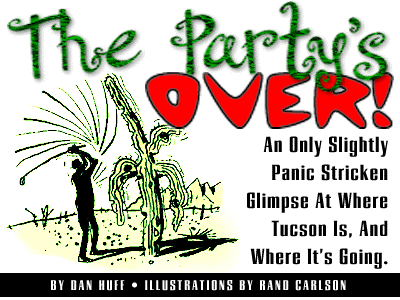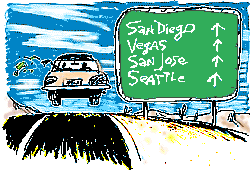 TUCSONANS HAVE BEEN whooping it up, relatively speaking, for most of the last 50 years. As a booming, post-World War II car-culture community, we've been sucking at a seemingly bottomless economic margarita made possible by the mind-blowing $7-trillion federal deficit. And there's no denying we've had a real good time--low crime (well, for most folks), cheap property taxes, affordable housing, plenty of room, good roads, okay schools.... All in all it's been great--thanks, Uncle Sam! But now it's 1996, and the party's nearly over. The Big Question is looming: Who'll clean up the mess? THIS IS WHAT it looks like in the Sonoran Desert after 50 years of high-living:
These houses are insulated poorly or not at all, sport cheap roofs and single-pane glass. They're the temporary boxes where we first landed when we cruised out from Iowa and Illinois and Pittsburgh. They're not beautiful or unique, and so they're not gentrifiable. And now the Newtsters in D.C. are cutting funding we might have used to rebuild our decaying suburban neighborhoods, even as vast tracts of these "units" are turning inexorably to crap....
After Tucson's population density reached its zenith in the modern era in 1953, at nearly 5,000 people to the square mile, the city fathers launched an 18-month blitzkrieg of annexations in 1959 and '60, laying claim to vast acreages on the south and east sides. Population densities plummeted. Annexations have continued, reaching a new fever's pitch only recently. Nothing bad about that, you say? People need their space; and with a couple of acres and a horse for Johnny, we've got a great lifestyle here! Well consider this: The taste for a low-density lifestyle carries with it a relatively high price due to all those empty lots with an underutilized sewer system running by them, all those extra miles on police tires going by all those empty 22nd Street frontages, all those good roads going everywhere and nowhere. You think it's not expensive to maintain a low-density city, just ask the folks pouring into the northwestern valley how they like their roads, or lack of them, at the moment. And remember: Except for a few rapidly desiccating chunks, the federal party platter has been devoured.
MEANWHILE, HALF OF Tucson's population rents, and 60 percent of the renters have been in their present digs less than 18 months. Talk about your basic formula for gross civic ignorance, this is it. The connection to the local zoning case, or what the neighborhood school's doing, is nonexistent. Schedule a public hearing and the new folks--half the frigging population--don't show at all, don't read the daily paper, don't vote and don't give a damn because they're on their way to Phoenix or Seattle or some other market for which Tucson is just another station of the cross. Hey, no wonder local TV news sucks. And even when we do commit to being Tucson homeowners, we typically tend to stay put only about three-and-a-half years before we move somewhere else in town.
Can you say "political suicide?"
For example, roughly between 1980 and 1990, Tucson's average household income, adjusted for inflation, received a swift kick in the balls, dropping from an average of $19,728 to $17,581 in constant 1982-'84 dollars. Average household income in Pima County dropped from $22,123 to $20,534.
But it gets worse. Between 1979 and 1989, thousands of middle-class Tucsonans found themselves tumbling into lower-class purgatory. The chart "Household Income," as they say, speaks for itself. And the "why" of it all is rather simple: During the last 20 years, we created almost no new wealth. Not in Tucson, not in Arizona and not in America. What you see in this chart below is a one-humped camel (1979) morphing into a two-humped camel (1989). And these days, the poor hump belongs to Rush Limbaugh and Pat Buchanan; in the old days when this type of painful transformation occurred among the middle classes, the poor hump belonged to a Huey Long or an Adolph Hitler. Allow us to pontificate: Any country where the middle class has, by any measure, declined and lost while a few made out like bandits has also bubbled with a potentially explosive them-versus-us zeitgeist. In Tucson today, as in the rest of America, where there's now a 50-50 chance the last half of the baby boomers won't be living as well as their parents, people are fearful and angry. We've already begun looking for reasons to be angry, for people to be angry at--poor Hispanics crawling under the wires seem to be the most popular scapegoats in today's California; the Nazis thought the Jews were to blame.
And if you don't care, remember this: Their kids will grow up real fast. And if one of them doesn't blow off your goddamn head in a pointless armed robbery, well maybe he'll just coldcock your daughter and grab her BMW.
If you want to see where Tucson could be in a decade or so, if you really need to know what disinvestment and white flight feel like, take a little daytrip to Phoenix. Start by standing in the shadow of the State Capitol, pick any direction and then walk for about two miles. But be sure to take your legally concealed handgun, because them dudes in the vast, surrounding 'hoods don't take no shit from nobody, and they don't take no 'Merican 'Spress.
Which means, of course, our unique Sonoran Desert environment--the only place in the U.S. with natural-born saguaros--will continue to get creamed. Hey, why don't we come together as one people, all grab our golf clubs some boring Sunday, and walk out in the desert and start whacking the holy crap of out those saguaros? The effect will be about the same in the long run as this constant edge development thing we've got going. Two-hundred years old? Whack! Been growing since the Plymouth Colony? Whack! It's easy and fun! And it might bolster the sense of community we're in danger of losing here, while relieving some of the psychic tension we experience because--unlike other cities--we aren't expanding into already-flattened farmland or some butt-ugly former Holstein dairy complex. Nope, in lieu of developing all that vacant land within our existing city limits, we're wisely bulldozing directly into a unique and irreplaceable ecosystem in search of the Good Life. We'll call our little festival Tucson Beat Yourself; the tourists'll just love it. OF COURSE, WE haven't had to face the issue of white flight yet, at least not in any big way compared to larger Western cities. So, to sum up, our real issues today are: • Can we keep holding hands? • Can we avoid the labeling? • Can we avoid the them-and-us trap the pressure of declining fiscal resources puts on our community, and; • Can we, meanwhile, find ways to repair decaying infrastructure, rehab older houses, upgrade streets, and, at the very least, keep the quality of life as good for our children as it was for us? •Oh yeah, and can we--please, God--preserve this unique Sonoran Desert environment? AND THE CORRECT answer is... ...No way, dickhead. We're Americans, goddamnit, and Westerners to boot. Ours is a gigantic country with plenty of opportunity elsewhere, and we've been running away from our problems for two centuries now. Hey, our grandma isn't buried here, and we move around so much that we don't have a speck of psychological equity in this Podunk pueblo. Roots? The closest thing we have to roots is that patch of rubber we'll be laying as we split for Portland or Seattle. Bye-bye and screw you, sucker. AHEM. LEADERSHIP, THAT'S the key to a brighter...oh, the hell with it...

A Bright Tomorrow
Tucson's Chief City Planner Says We're Facing Better Days Ahead--If
Only We Can Deal Effectively With Today's Problems.
DAVID TAYLOR, TUCSON'S chief city planner, compiled the statistics on which the accompanying story was based. It's his job, and he has no control over how media scum might twist his research. Taylor, an erudite and humorous man--who is also independently wealthy--is loathe to offer opinions on the data. He says that's up to the voters and the politicians they elect, not humble civil servants like himself. Nevertheless, he can deliver one hell of a speech on the subject (some of which was lifted for the accompanying article) and overall he's decidedly upbeat about Tucson's future. "Are we any better than the people who brought you Los Angeles?" he asks. "Well, I don't know yet. But I'm not frightened of the problems I see in front of us." He notes plenty of other Western cities face the same problems, but he argues Tucson's prospects are brighter than most. Taylor predicts the North American Free Trade Agreement (NAFTA) could mean excellent jobs and a strong economy for the next generation of Tucsonans, especially when one considers the city's proximity to Guaymas, Sonora, Mexico. "I mean think about it. Tucson's original port of entry was Guaymas, the greatest deep-water port as yet unbuilt on the face of the earth," he says. "And everything that lands in western Mexico must go through Tucson before it moves east or, because of the Cordiera Mountains, west." Which means, Taylor says, one day the area around Tucson International Airport could look a lot like Mesa, as it becomes a powerhouse job-generating nexus: "Take the terminus of big water, a big gas pipe, a big railroad, a big air terminal, a huge electrical grid going down to the mines, and lots of dirt; if you're an economic geographer, you're probably thinking we can't miss." Taylor speculates, rhetorically anyway, that Tucson may grow south to meet Hermosillo, Sonora, long before it grows north, to join Phoenix in some amebic economic unit. That's because Mexico "is a huge, yawning market full of energy and stuff. And we have the people by tradition, by family connection, by language, by ethnicity, who are going to make those deals and work that trade." It helps, he adds, to have a University of Arizona "that can instantly sell expertise to that market, which is what you do in an information age--you sell expertise, not your labor." In fact, Taylor sees the nation's uneven transition to the Information Age--and not the "Reagan/Bush Miracle"--as a big part of the national and local problem of stalled wealth creation and the resulting potential lack of money for infrastructure and government services. And within this wrenching transition, he sees hope: "If you look at how American competitiveness is doing, if you look at our productivity--basically, it's almost like a physical law: An increase in productivity almost always means an increase in quality of life--we've done the best of any industrialized nation in the last 10 years."
So maybe look for us to do better, he says, adding, "Ninety-nine
percent of the world would trade their problems for ours. So I
don't feel confused, I don't feel threatened, I don't feel cynical
about the stuff that's in front of us. But it is in front of us.
And it's got to be dealt with."
--Dan Huff
|
 |
Home | Currents | City Week | Music | Review | Cinema | Back Page | Forums | Search
 |
© 1995-97 Tucson Weekly . Info Booth |
|